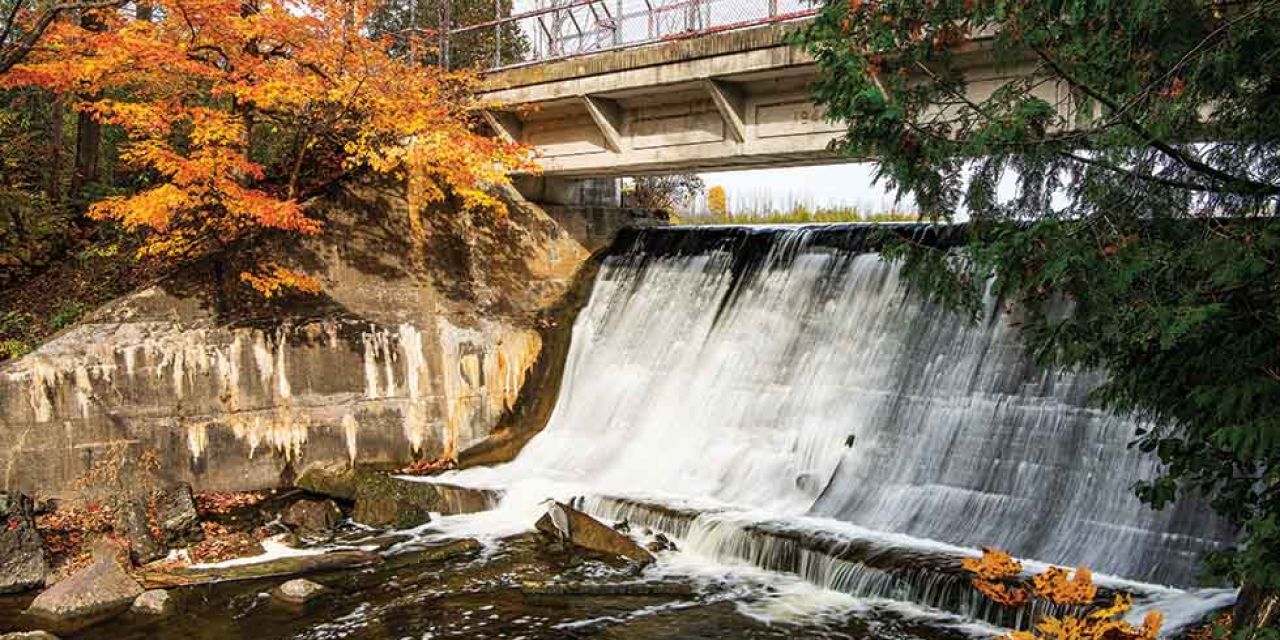A great blue heron enjoys an autumn afternoon at Holstein Dam.
Changing Currents
by Cara Williams | photography by Clay Dolan
A reflection on the past, present, and future of our region’s dams and their role in shaping our rivers and communities.
As autumn settles in, the rivers and streams along the Escarpment take on a new life, their flow controlled and guided by a series of dams that have stood as silent sentinels for decades. These dams not only manage water levels and prevent flooding, but they also play a crucial role in supporting local ecosystems, such as facilitating fish migration during spawning seasons. As the leaves change colour and the water begins to cool, the activity around these dams intensifies, making autumn a pivotal time for both human and natural communities. Each dam has its own story, a blend of engineering marvel, local history, and the community’s relationship with the natural world.
Thornbury Dam
Located in the heart of Thornbury, the Thornbury Dam at the Mill Pond is a historic landmark deeply intertwined with the town’s industrial past. Built in the early 1900s, the dam originally powered local mills, which were central to Thornbury’s economy at the time. Over the years, as the town’s needs shifted, the dam transitioned from an industrial workhorse to a key player in water management and ecological preservation. Today, the Thornbury Dam is renowned for its fish ladder, installed in the 1950s to allow salmon and trout to bypass the dam during their spawning runs. Over the past 160+ years, the dam, mill, and fishway have transformed. The east side of the bridge features the fishway, while the west houses a power generator. The old sawmill has been restored and now operates as The Mill restaurant. Although the landscape has changed, fish behaviour remains the same, with the Town making their spawning journey easier and more efficient. In recent years, the Thornbury Dam has also become a focal point for community engagement and environmental education. Local initiatives have highlighted the dam’s role in preserving fish populations, and it has become a popular spot for educational programs about the importance of sustainable water management. The dam not only serves as a reminder of Thornbury’s industrial roots but also as a beacon for the town’s future, where conservation and community go hand in hand.
Clendenan Dam
Clendenan Dam, located along the Beaver River in Clarksburg, is a vital piece of local water management infrastructure. Constructed in the 1950s, the dam was designed primarily to control flooding, a frequent challenge in the region due to the river’s unpredictable flow. Over the years, it has been carefully maintained, continuing to protect downstream communities from the seasonal flooding that can occur during periods of heavy rain. The history of Clendenan Dam is closely linked with the local agricultural community. Farmers have long depended on the dam to regulate water levels, ensuring that their fields remain fertile and well-watered without the risk of flooding. As autumn brings increased rainfall, the dam’s importance becomes even more evident, as it manages the river’s flow and keeps the surrounding lands safe. The area around the dam is also a popular spot for anglers, who value the dam’s contribution to maintaining healthy fish habitats along the Beaver River.

Anglers fishing on the Beaver River below the Thornbury Dam.
The dam is set within a 119-acre conservation area, offering easy walking trails that allow visitors to explore the natural beauty of the region. In addition to the impressive flood control structure, Clendenan Dam also features a built-in fish ladder on its left wing—a rectangular passage that enables Chinook salmon and rainbow trout to continue their spawning routes. This combination of flood control, ecological preservation, and recreational opportunity makes Clendenan Dam an essential asset to the community.
Dam at Slabtown
The Slabtown Dam is one of the oldest in the region. Originally built in the late 1800s to support a thriving lumber industry, the dam, situated in the small hamlet of Slabtown near Clarksburg, has seen many changes over the years. While the sawmills have long since closed, the dam remains a vital part of the local landscape, now serving as a reminder of the area’s industrial past. It’s important to note that the dam is located on private property, so while its historical significance is appreciated by many, public access is limited, and visitors should respect property boundaries.
During the fall, visitors to the area are often struck by the serenity of the surroundings. The decommissioned dam creates a calm reservoir, framed by trees ablaze with autumn colours. The Beaver River is a popular spot for kayaking and fishing, and the dam’s history is still visible in the remnants of the old millworks nearby, offering a glimpse into the region’s industrious past while also highlighting how the dam has transitioned into a more environmentally focused role.
For decades, the Slabtown Dam also played a role in the infamous Beaver River Rat Race, an annual canoe race that attracted thrill-seekers from far and wide. Although the event was eventually cancelled due to safety concerns, its legacy remains a part of local lore, adding an extra layer of history to this already storied site. The dam’s enduring presence is a testament to Slabtown’s rich heritage, even as it remains tucked away on private land.

Autumn splendour at Clendenan Dam.

A rainbow trout leaps toward the dam at Slabtown.
Holstein Dam
Nestled in the scenic countryside between Mount Forest and Durham, the Holstein Dam is a lesser-known but equally important part of the region’s infrastructure. Built in the 1930s as part of a rural development initiative, the dam was primarily constructed to provide a reliable water source for the surrounding agricultural lands. Over time, it has also become a well-used recreational area, known for its peaceful surroundings and the abundant wildlife that flourishes there.
The Holstein Dam Falls in Holstein Jubilee Park flows over the dam from the mill pond on Norman Reeves Creek, enhancing the park’s appeal. The best view of the falls is from just downstream at the park entrance, where visitors can fully appreciate the cascading water. Another unique vantage point is from the old railway trail along the top of the dam, where the waterfall can be seen from above on the historic railway bridge.
In autumn, Holstein Dam is particularly beautiful, with the surrounding woods providing a vibrant backdrop to the calm waters. The dam itself is a testament to early 20th-century engineering, its sturdy construction having withstood the test of time. The area is a favourite among birdwatchers and nature enthusiasts who come to enjoy the tranquility and the chance to observe various species preparing for winter. The dam’s significance to the local community is highlighted by its ongoing maintenance, ensuring it continues to serve both practical and recreational purposes.
Dam at McGowan Falls
Within the Durham Conservation Area, the dam at McGowan Falls is a serene and picturesque spot on the Saugeen River. Named after an early miller who harnessed the river’s power for milling, the falls are a testament to the region’s rich history of industry and community. Unlike some of the more dramatic waterfalls in the region, McGowan Falls are gentle and gradual, cascading over a series of rock ledges surrounded by dense cedar forests. This tranquil setting offers visitors a peaceful retreat, where the sounds of flowing water and rustling leaves create a calming atmosphere.
McGowan Falls is a favourite among anglers, particularly during the autumn months when the Saugeen River comes alive with fish making their upstream journey. The falls help to maintain a steady flow in the river, ensuring healthy fish populations and a vibrant ecosystem. The surrounding Durham Conservation Area is popular for hiking, picnicking, and birdwatching, making it an ideal destination for those looking to enjoy the natural beauty of the region.
In addition to its natural allure, McGowan Falls holds a special place in the cultural life of Durham. The falls are immortalized in one of several murals that adorn the buildings in downtown Durham, celebrating the town’s connection to its natural surroundings and its history. This mural, along with others in the town, offers a visual journey through the past, reminding residents and visitors alike of the enduring importance of the Saugeen River and the role that McGowan Falls has played in the community’s development. Whether you’re drawn by the fishing, the hiking, or simply the serene beauty of the falls, McGowan Falls is a spot that captures the essence of autumn in our region.

The Sydenham River cascading over the Owen Sound Mill Dam.
Owen Sound Mill Dam
The Owen Sound Mill Dam is a crucial component of the city’s. infrastructure, managing the flow of the Sydenham River as it courses through Owen Sound and into Georgian Bay. Constructed in the early 20th century, the dam was originally built to power local industry and mitigate flooding in the downtown area. While it continues to fulfill these essential roles, the dam has also become a focal point for recreational activities.
Autumn at the Mill Dam is particularly noteworthy for the annual fish migration, drawing anglers and visitors eager to experience the vibrant activity along the city’s waterfront. The dam presents a striking contrast to its urban surroundings, with the river flowing swiftly beneath the canopy of changing trees, right through the heart of Owen Sound. Its history is deeply intertwined with the city’s development, making it a vital part of the community that bridges the needs of urban life with the natural environment. A visit to Ontario’s first fish ladder, located at the dam, offers the opportunity to witness the impressive migration of rainbow trout and Chinook salmon from September to October. The dam is conveniently located on the east side of 2nd Avenue West, between 4th and 7th Streets West.
Denny’s Dam
Denny’s Dam, located on the Saugeen River near Southampton, is a notable structure with a history deeply connected to the local fishing industry. Originally built in 1905 by John Denny to power his sawmill, the dam has undergone several transformations over the years. The current concrete structure, completed in 1970, replaced the original wooden dam and has since become a key component in fish management efforts along the Saugeen River.
Today, Denny’s Dam is particularly significant for its role in supporting the migration of salmon and trout, as it includes a fish ladder that allows these species to bypass the barrier during their spawning runs. This feature has made the dam a popular spot for anglers and nature enthusiasts, especially in the autumn when Chinook salmon and rainbow trout make their impressive journey upstream. The area around the dam is not only a hub for fishing but also a scenic spot where visitors can appreciate the river’s natural beauty.
The history of Denny’s Dam reflects the region’s evolving relationship with its waterways, shifting from industrial use to conservation and recreation. Its continued importance to the community underscores the value of balancing human needs with environmental stewardship, making Denny’s Dam a cherished landmark along the Saugeen River.
The dams of our region are more than just concrete and steel; they are woven into the fabric of our local history and continue to play a vital role in managing our waterways, supporting local ecosystems, and providing recreational opportunities. As the autumn leaves fall and the rivers swell with the season’s rains, these dams stand as a testament to the enduring relationship between our communities and the natural environment. Whether you are drawn by their history, their engineering, or the natural beauty they help to preserve, these dams offer a unique glimpse into the past, present, and future of our region. E







